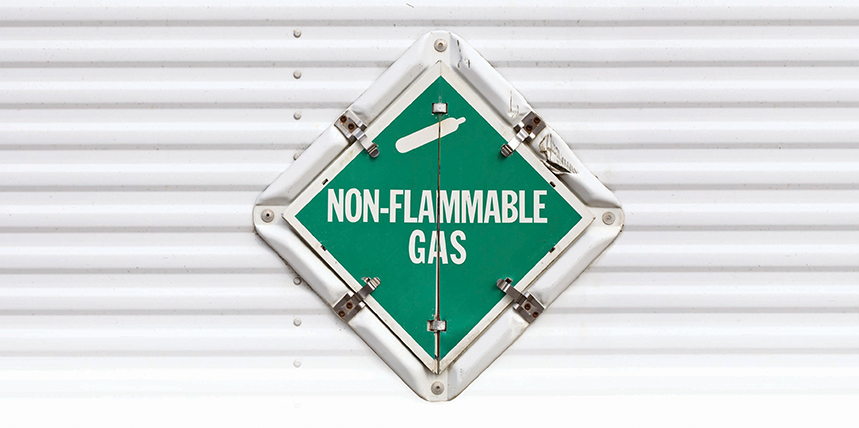Sulfur hexafluoride, also known as SF6 gas, is a commonly used and excellent insulator found in many medium to large circuit breakers protecting transmission and distribution equipment. It has been argued that gas-filled breakers are superior to those filled with oil, air, or a vacuum. They operate cooler and with no noise or gas emissions and are considered relatively low maintenance compared to other types. However, as is the case with many chemicals used in the workplace, the use of sulfur hexafluoride carries inherent dangers.
In its normal state, sulfur hexafluoride gas is:
- Colorless
- Odorless
- Non-flammable
- Non-toxic to humans
Under high temperature conditions (greater than 350 degrees F), sulfur hexafluoride decomposes into toxic and corrosive by-products. Decomposition can occur when sulfur hexafluoride is exposed to spark discharges, partial discharges, switching arcs, and failure arcing. While pure sulfur hexafluoride is odorless, contaminated sulfur hexafluoride has an unpleasant, pungent odor.
Exposure to these by-products, typically found in the form of gases or powders, can cause several health conditions:
- Irritation to the eyes, nose, and throat
- Pulmonary edema
- Other lung damage, skin and eye burns, nasal congestion, bronchitis
- Dermatitis (skin rash or inflammation)
In addition to hazards associated with decomposition by-products, the hazards typically involved with the analysis, testing, and maintenance of any electrical equipment also apply to medium- and high-voltage sulfur hexafluoride breakers.
Chemical Hazards
Sulfur hexafluoride is denser than air. This means any released gases may settle into lower areas such as trenches, displacing the oxygen. This is a potentially hazardous situation for any employee entering the trench. Humans require an oxygen level between 19.5 percent and 21 percent. The minimum allowable oxygen level — called the permissible oxygen level by the Occupational Safety and Health Administration (OSHA) — is 19.5 percent. If a gas leak is suspected, an oxygen meter that has been recently calibrated and bump tested must be used to detect whether the oxygen is depleted to ensure there is no hazard to an employee.
Lower-order gases formed when sulfur hexafluoride is subjected to an arc are a potential toxicity hazard that may cause an employee to suffer from irritation to the eyes and respiratory system. Additionally, the sulfur hexafluoride gas will decompose into highly hazardous metal fluorides. If metal fluorides are subjected to moisture, such as that on an average humid day, decomposition by-products will include sulfur oxyfluoride as well as hydrofluoric and sulfuric acids. These by-products, which appear as a white or grayish powdery substance, are easy to detect because they smell of rotten eggs. Respiratory protective equipment must be worn if these decomposition by-products are suspected. Face shields, nitrile gloves, and Tyvek splash suits are also required to minimize potential exposure when handling contaminated equipment.
Sulfur hexafluoride is designated a greenhouse gas by the U.S. Environmental Protection Agency (EPA), and many utilities are required to report known leakages. Please contact your EPA representative to determine whether this is the case.
Physical Hazards
Cylinders that store virgin sulfur hexafluoride gas are heavy and cumbersome. It is a gas under pressure, so special precautions must be used when handling the containers:
- Cylinders must be secured to prevent tipping.
- Protective caps must be in place over the valve when the cylinder is not in use.
- Transport of quantities over a certain limit requires U.S. Department of Transportation placarding and a bill of lading. Please see Department of Transportation regulations if you will be hauling bottles of sulfur hexafluoride.
Due to the weight of the bottles, a group lift is suggested, and specialized tools such as bottle grabs or carts can assist. Working smart, not hard, helps prevent injuries; if a tool is available to ease movement of the cylinder, use it. Employees have strained muscles, tripped and fallen, and even chipped teeth carrying cylinders by hand. Do not become a statistic by trying to be a hero. Get help or use tools to prevent the possibility of physical injury.
Additional personal protective equipment may be necessary depending on the task and workplace requirements. Wear all applicable personal protective equipment when handling anything heavy.
- Durable work gloves can help protect your hands if pinched between bottles.
- Safety-toed, appropriately rated work boots are required. In many work environments using sulfur hexafluoride gas, boots must be electrical-hazard rated.
- While a bottle is in use, rapid and long-duration venting can cause freezing on the surface of the bottle due to condensation in the air. It is cold enough to cause frostbite if in contact with human skin for an extended time. Gloves can minimize the potential of contact with the cold surface of the bottle.
Sulfur hexafluoride gas recycling and reclaiming equipment is also heavy. It is usually wheeled, but a group effort is still required to minimize the potential for injury, especially if taking it out of or off a vehicle. Always read the instruction manual prior to use of unfamiliar equipment and have an experienced coworker train you in its use. Many hoses and components are under pressure, so caution must be used when using tools around the equipment.
Conclusion
Sulfur hexafluoride breakers are one of the most effective inventions for protecting electrical equipment, but their use can become a disadvantage. Caution above and beyond the usual electrical hazards must be used when working with any chemical, pressurized gas, or heavy object. No matter the job, use these rules to help ensure the work is carried out safely:
- Establish and barricade a safe work area.
- Perform a pre-job brief with all employees on the site.
- Wear proper PPE for each task.
- De-energize and perform lock out/tag out.
- Verify zero energy (test, check, test) and discharge all stored energy, including pressurized gases.
- Connect grounds where and if applicable.
- Use the available tools to make the job easier to perform.
- Identify, visually mark, and/or flag equipment being worked on.
Following these steps can lead to a safer work environment while on and around SF6 gas and the electrical equipment that uses it.
 Paul Chamberlain has been the Safety Manager for American Electrical Testing Co., LLC since 2009. He has been in the safety field for the past 20 years, working for various companies and in various industries. Paul holds a BS in environmental health and safety from Massachusetts Maritime Academy.
Paul Chamberlain has been the Safety Manager for American Electrical Testing Co., LLC since 2009. He has been in the safety field for the past 20 years, working for various companies and in various industries. Paul holds a BS in environmental health and safety from Massachusetts Maritime Academy.
